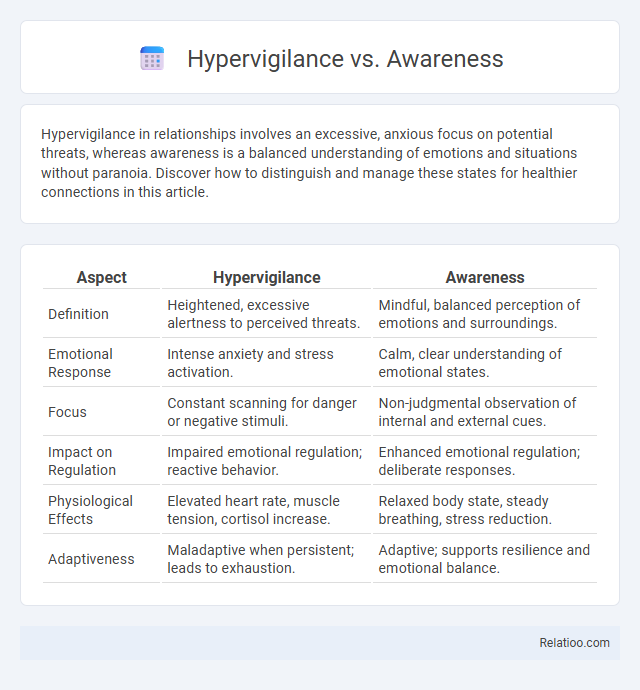Hypervigilance in relationships involves an excessive, anxious focus on potential threats, whereas awareness is a balanced understanding of emotions and situations without paranoia. Discover how to distinguish and manage these states for healthier connections in this article.
Table of Comparison
| Aspect | Hypervigilance | Awareness |
|---|---|---|
| Definition | Heightened, excessive alertness to perceived threats. | Mindful, balanced perception of emotions and surroundings. |
| Emotional Response | Intense anxiety and stress activation. | Calm, clear understanding of emotional states. |
| Focus | Constant scanning for danger or negative stimuli. | Non-judgmental observation of internal and external cues. |
| Impact on Regulation | Impaired emotional regulation; reactive behavior. | Enhanced emotional regulation; deliberate responses. |
| Physiological Effects | Elevated heart rate, muscle tension, cortisol increase. | Relaxed body state, steady breathing, stress reduction. |
| Adaptiveness | Maladaptive when persistent; leads to exhaustion. | Adaptive; supports resilience and emotional balance. |
Understanding Hypervigilance: Definition and Signs
Hypervigilance is an intense state of heightened sensory sensitivity and an exaggerated focus on potential threats, often resulting from trauma or chronic stress. Unlike general awareness, which allows you to calmly and accurately perceive your surroundings, hypervigilance causes your nervous system to remain on high alert, leading to symptoms such as rapid heartbeat, irritability, and difficulty concentrating. Understanding these signs helps differentiate hypervigilance from normal awareness and guides effective management strategies for your mental well-being.
What Is Awareness? Key Traits and Benefits
Awareness is a heightened state of conscious perception where you recognize and interpret your environment without excessive fear or anxiety. Key traits include mindfulness, clarity, and emotional regulation, allowing you to respond thoughtfully rather than react impulsively. This balanced state improves decision-making, enhances emotional intelligence, and promotes overall mental well-being.
Hypervigilance vs Awareness: Core Differences
Hypervigilance involves an excessive state of sensory sensitivity and heightened anxiety, often linked to trauma or PTSD, causing individuals to constantly scan for threats. Awareness, in contrast, is a balanced, mindful state of paying attention to the present moment and environment without distress or hyperreactivity. The core difference lies in the emotional response: hypervigilance triggers stress and fear, while awareness fosters calm and clarity.
Psychological Roots of Hypervigilance
Hypervigilance arises from heightened sensitivity in the brain's threat detection systems, often linked to trauma or anxiety disorders, impacting your ability to focus and perceive safety accurately. Unlike general awareness, which involves balanced, situational attention, hypervigilance keeps your nervous system in a constant state of alert, making it difficult to relax or differentiate between real and perceived threats. Understanding these psychological roots helps in managing hypervigilance by developing healthier cognitive and emotional responses to stress.
The Role of Mindfulness in Developing Awareness
Mindfulness plays a crucial role in developing awareness by training the brain to observe thoughts and sensations without judgment, enhancing conscious perception rather than reactive vigilance. Unlike hypervigilance, which triggers heightened and often anxiety-driven sensitivity to perceived threats, mindfulness fosters balanced awareness that promotes emotional regulation and presence. This cultivated awareness allows individuals to respond thoughtfully to stimuli rather than reacting impulsively, improving mental clarity and reducing stress-related hyperarousal.
Impact of Hypervigilance on Mental Health
Hypervigilance, characterized by an excessive and persistent state of heightened alertness, significantly impacts mental health by increasing anxiety, stress, and emotional exhaustion. Unlike awareness, which involves a balanced and adaptive perception of your surroundings, hypervigilance overwhelms your cognitive resources and disrupts normal functioning. Managing hypervigilance is essential for maintaining mental well-being and reducing the risk of developing chronic anxiety disorders or PTSD.
Advantages of Cultivating Genuine Awareness
Cultivating genuine awareness enhances Your ability to stay grounded in the present moment, improving emotional regulation and reducing stress compared to hypervigilance, which often triggers anxiety and excessive scanning for threats. Unlike hypervigilance, genuine awareness fosters clearer perception and better decision-making without overwhelming sensory input. This balanced state supports mental well-being and promotes resilience by helping You respond thoughtfully rather than react impulsively to environmental stimuli.
Hypervigilance in Trauma and Anxiety Disorders
Hypervigilance in trauma and anxiety disorders manifests as an excessive state of sensory sensitivity and heightened alertness to potential threats, often disrupting daily functioning and causing significant distress. Unlike general awareness, which involves balanced perception and mindfulness of your surroundings, hypervigilance triggers an overwhelming focus on perceived dangers, leading to constant scanning for signs of harm. Understanding these distinctions helps in managing symptoms more effectively and fostering a sense of safety and control.
Practical Strategies to Shift from Hypervigilance to Awareness
Shifting from hypervigilance to awareness involves cultivating mindfulness techniques that anchor Your attention to present-moment experiences without judgment. Practical strategies include deep breathing exercises, grounding techniques, and cognitive reframing to reduce heightened threat sensitivity while enhancing situational understanding. These approaches promote a balanced state where vigilance is adaptive, allowing you to respond calmly and effectively.
Building Long-Term Resilience Through Awareness
Awareness enhances long-term resilience by promoting mindful observation of thoughts, emotions, and surroundings without immediate judgment or reaction. Hypervigilance, characterized by excessive and constant scanning for threats, often leads to heightened stress and decreased cognitive resources. Building resilience requires cultivating balanced awareness that supports adaptive responses, emotional regulation, and sustained mental well-being over time.

Infographic: Hypervigilance vs Awareness
 relatioo.com
relatioo.com